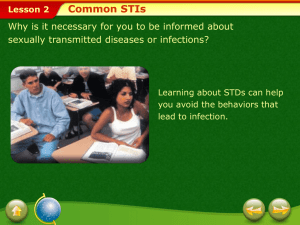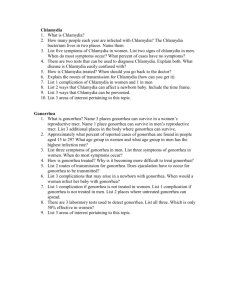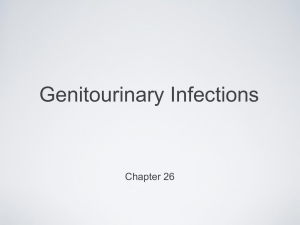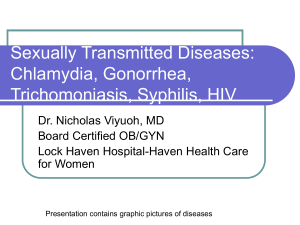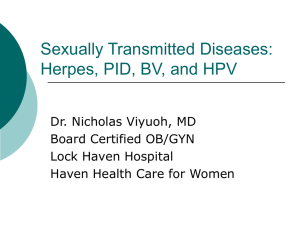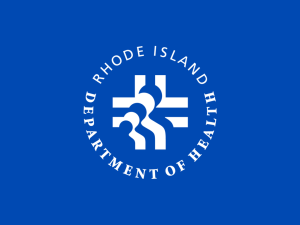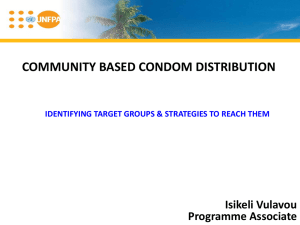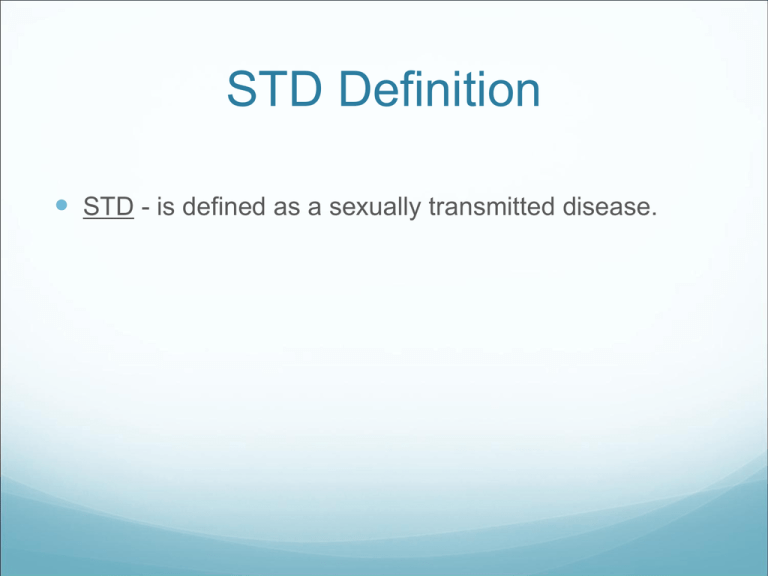
STD Definition
STD - is defined as a sexually transmitted disease.
These Topics Related to
STDs
Condoms
Genital Herpes
Gonorrhea
Syphilis
HPV
Chlamydia
Condoms
Definition/Brief History
Condom - A flexible sheath, usually made of thin rubber or latex,
designed to cover the penis during sexual intercourse for contraceptive
purposes or as a MEANS OF PREVENTING SEXUALLY TRANSMITTED
DISEASES.
Brief History - Condom use has been around since around 1000 BC, but
it wasn’t widely used until World War II, when military leaders tried to curb
venereal disease by distributing condoms to Allied troops and promoting
them with slogans like "Put it on before you put it in." When the soldiers
returned home, condom popularity skyrocketed among civilians. During
the ‘60s through the ‘70s, condom took a back seat to a new form of
contraceptive called, which was the pill. During the ‘80s the condom had a
revival due the threat of AIDS, and more people started to use them to
protect them from HIV.
Primary Purpose of Condoms
The condom’s primary purpose is to keep bodily fluids
from different people, separate. Obviously it helps
prevent pregnancy by keeping the sperm from entering
the eggs. It also helps prevent diseases that are
transmitted mainly through contact with sexual fluids,
like semen and vaginal lubricant.
How to Use a Condom
Take the condom out of its
package, and hold it right-side
up by the tip of the condom.
Then, place it over the erect
penis and carefully unroll the
condom down the length of the
penis. After ejaculation, hold the
rim of the condom to keep it
from slipping off. Remove the
condom carfully, wrap it in
tissue, and put it in the garbage.
NOT IN TOILET. NEVER
REUSE CONDOMS.
Condom Use & Disease
Prevention Facts
There are more than 30 types of bacteria that can move from
person to person as a result of sexual activity. People get STDs
because of fluid exchange during sex. Condoms physically block
fluids, preventing disease. Condoms can possibly break or be
defective but what makes a latex condom so effective is that it
doesn’t have pores that can allow microorganisms to pass through
the condom.
However, some STIs like genital warts, genital herpes and pubic
lice can be transmitted because of areas that are not covered by
condoms.
If you’re having sex with someone that has HIV, there is almost no
chance of getting it if a condom is being worn.
Condom Conclusion
Abstinence is the only true way to prevent any STD.
Best alternative is to practice safe sex by wearing a
condom for any sexual encounter.
What is Genital Herpes?
Genital Herpes is a common virus that can cause sores
in and around the genital area and it can also be
transmitted to other regions of the body.
How Do You Get Herpes?
By direct contact with the sores or blisters of an infected person.
For example:
Having vaginal, anal or oral sex with someone with genital sores.
If a mother has genital sores during childbirth, herpes can be passed to the baby.
The virus can be spread when you cannot see any sores.
This happens by viral shedding right before an outbreak, or if sores are hidden inside the vagina.
How Do You Know If You Have
Herpes?
You may have:
Tingling or itching of the skin around the genitals.
One or a group of painful, watery blisters in or around the genitals, or
wherever there is skin to skin contact (hips, nipples, anus).
These blisters break and form open sores that crust or scab lasting 7
- 21 days.
Burning when you urinate (pee).
Flu-like symptoms (usually during the first outbreak).
Tender, swollen glands in the groin.
Symptoms that start 2 - 21 days after contact with an infected person,
but may take weeks or months to appear.
Outbreaks of herpes that vary and can return as often as every month or
as rare as once a year or longer.
Stress, illness, diet, fever, sun exposure, your period, pregnancy or
vigorous sex may cause outbreaks.
How Do You Get Tested?
How Do You Treat Genital
Herpes?
HOW TO GET TESTED
Visit a doctor as soon as you have an outbreak.
A doctor can diagnose the herpes by looking at the sores or by taking
a swab of the sore to check for the virus.
Sometimes, during a pelvic exam, herpes can be seen on the cervix.
http://www.stdresearch.org/anonymous-std-testing-glassboro-nj.html
TREATMENT
Medicine can help shorten or prevent outbreaks and ease the pain, but
there is no cure for herpes.
Keep the area clean and dry, as this will help healing.
How Can You Prevent The Spread
Of Herpes?
Abstinence (not having sex) is your best choice.
If you think that you have been infected, get checked out.
Do not have any sexual contact with someone who has sores on the genitals.
Do not have any sexual contact if you have sores on your genitals.
Practice “Safer Sex”. Always use condoms but remember that condoms will not protect you if the sores are not covered.
Limit the number of sexual partners you have.
Ask your partner about his/her sexual history.
Tell your partner if you have an infection.
Get education, guidance and support.
Herpes can be passed between partners even when there
are no signs of the disease.
Famous People with Genital
Herpes
Liza Minnelli
Paris Hilton
Ann Heche
Robin Williams
Billy Idol
Michael Vick
David
What is Gonorrhea?
Gonorrhea- is a sexually transmitted disease (STD).
Gonorrhea is caused by Neisseria gonorrhoeae, a bacterium
that can grow and multiply easily in the warm, moist areas of
the reproductive tract, including the cervix (opening to the
womb), uterus (womb), and fallopian tubes (egg canals) in
women, and in the urethra (urine canal) in women and men.
The bacterium can also grow in the mouth, throat, eyes, and
anus.
Gonorrhea occurs second only to chlamydia among bacterial
STD’s in the U.S.
How Gonorrhea is contracted and
or spread?
The Centers for Disease Control and Prevention have estimated
that more than 700,000 persons get new Gonorrheal infections
each year.
Gonorrhea is spread through contact with the penis, vagina,
mouth, or anus involving a person or persons infected by the
bacteria. Ejaculation does not have to occur for gonorrhea to be
transmitted or acquired. Gonorrhea can also be spread from
mother to baby during delivery.
Myths revealed: Gonorrhea CANNOT be spread by sharing
toilets and bathrooms.
People who have had gonorrhea and received treatment MAY
get infected AGAIN if they have sexual contact with a person
infected with gonorrhea.
Signs and Symptoms
MEN
-Some men with gonorrhea may have no
symptoms at all. However, some men
have signs or symptoms that appear two
to five days after infection; symptoms
can take as long as 30 days to appear.
Symptoms and signs include a burning
sensation when urinating, or a white,
yellow, or green discharge from the
penis. Sometimes men with gonorrhea
get painful or swollen testicles.
•
BOTH
-Symptoms of rectal infection in both men
and women may include discharge, anal
itching, soreness, bleeding, or painful
bowel movements. Rectal infection also
may cause no symptoms. Infections in
the throat may cause a sore throat, but
usually causes no symptoms.
WOMEN
-In women, the symptoms of gonorrhea are
often mild, but most women who are
infected have no symptoms. Even when
a woman has symptoms, they can be so
non-specific as to be mistaken for a
bladder or vaginal infection. The initial
symptoms and signs in women include a
painful or burning sensation when
urinating, increased vaginal discharge,
or vaginal bleeding between periods.
Women with gonorrhea are at risk of
developing serious complications from
the infection, regardless of the presence
or severity of symptoms.
Signs and Symptoms of Gonorrhea
How to treat Gonorrhea?
Several antibiotics can successfully cure gonorrhea in
adolescents and adults. However, drug-resistant strains of
Gonorrhea are increasing in many areas of the world,
including the United States, and successful treatment of
gonorrhea is becoming more difficult. Because many people
with gonorrhea also have Chlamydia, another STD,
antibiotics for both infections are usually given together.
-Persons with gonorrhea should be tested for other STDs.
HELP: Division of STD Prevention (DSTDP)
Centers for Disease Control and Prevention
www.cdc.gov/std
CDC-INFO Contact Center
1-800-CDC-INFO (1-800-232-4636)
Email: cdcinfo@cdc.gov
Prevention of Gonorrhea
-The surest way to avoid transmission of STDs is to abstain
from sexual intercourse, or to be in a long-term mutually
monogamous relationship with a partner who has been tested
and is known to be uninfected.
-Latex condoms, when used consistently and correctly, can
reduce the risk of transmission of gonorrhea.
Resources
-http://www.cdc.gov/std/gonorrhea/stdfactgonorrhea.htm
-http://en.wikipedia.org/wiki/Gonorrhea
Syphilis
Syphilis
“The Great Imitator”
Bacterial infection
Spread through direct contact
(vaginal, anal, oral sex)
Cannot be spread through
indirect contact (door knobs, toilet
seats, hot tubs, etc.)
Sores usually appear on the
genitals, anus, or in the rectum
Can also appear on lips and
mouth
Pregnant women can pass it to
their baby!
Primary Stage
Single sore (chancre)
usually, but may be more
than one
Average of 21 days
between infection and first
symptom
Lasts 3-6 weeks, may heal
without treatment, or may
progress to secondary
stage
Secondary Stage
Skin rashes and lesions
More than one spot on the
body
Fever, swollen lymph glands,
patchy
Will resolve with or without
treatment
Without treatment, can progress
to latent stage
Latent
Develops in 15% of untreated
people
Can appear for 10-20 years
after infection
Internal organs - brain, nerves,
eyes, heart, blood vessels, liver,
bones, joints
Symptoms - muscle
coordination difficulty, paralysis,
numbness, gradual blindness,
dementia.......
And possibly death!
Statistics
From 2004-2008, the rates of primary and secondary syphilis
increased the most among men and women aged 15-24
In 2006, there were over 36,000 cases of syphilis, with 9,756
reported as primary and secondary syphilis
Half of all primary and secondary cased were from people in
20 counties and 2 cities
There were 349 new cases of congenital syphilis on
newborns
In 2008, 63% of the reported primary and secondary syphilis
cases were among men who had sex with them
Prevention
Abstinence
From sexual activity
From intimate physical contact
The bacteria that causes syphilis can travel through
parts of the body not protected by a condom
Resources
http://www.cdc.gov/std/Syphilis/STDFact-Syphilis.htm
http://en.wikipedia.org/wiki/Syphilis
HPV
Little Known Facts About HPV
-90% of all cases will be cleared by the body’s immune
system within 2 years
It can sometimes cause genital warts
It can sometimes cause cervical cancer
Also known as Human Pappiloma Virus
Signs and Symptoms
Genital warts can usually appear to be and can be flat, raised or shaped
like cauliflower, small or large
Women can get cervical cancer but it does not have any symptoms.
It can cause other cancers such as cancer of the: vulva, vagina and penis
People can also get RRP which causes warts to grow in their throat.
These warts can cause troubled breathing since they block the airway.
How do you get HPV?
HPV gets passed through genital contact, most often
during vaginal and anal sex. It can also be passed
through oral sex and even just genital touch.
How common is HPV?
Approximately 20 million americans are currently
infected with HPV. Another 6 million are newly infected
each year.
HPV is so common that atleast 50% of all sexually
active men and women will get it at some point in their
lives.
How can you prevent HPV?
Girls and women: Two vaccines are available to protect
against HPV. The Gardasil shot prevents most genital
warts.
Boys and Men: One vaccine is available, Gardasil, and
it protects males against most genital warts.
Using condoms can prevent HPV, however it can infect
areas that are not covered by a condom.
Abstinence
Treatment of HPV
Genital warts: Can be removed by the patient with
medications, and can also be treated by medical providers.
Some people choose to just let them go away on their own.
Cervical Cancer: It is most treatable when caught early.
Women who get routine pap test and follow up as needed can
identify problems BEFORE cancer starts.
Other Cancers: Also more treatable when diagnosed early.
RRP: Can be treated with surgery or medicines. It can
sometime take many treatments over a period of years.
What is Chlamydia?
Chlamydia is a common infectious cause of genital and eye
diseases in humans.
Chlamydia trachomatis a bacterium that only infects humans.
It is the leading bacterial STI worldwide.
Bio on Chlamydia
Chlamydia is known as the "Silent Epidemic" because
in women, it may not cause any symptoms in 75% of
cases and can linger for months or years before being
discovered. Symptoms that may occur include: unusual
vaginal bleeding or discharge, pain in the abdomen,
painful sexual intercourse , fever, painful urination or
the urge to urinate more frequently than usual urinary
urgency.
In men, Chlamydia shows symptoms of infectious urethritis
(inflammation of the urethra) in about 50% of cases.
Symptoms that may occur include: a painful or burning
sensation when urinating, an unusual discharge from the
penis, swollen or tender testicles, or fever. Discharge, or the
purulent exudates, is generally less viscous and lighter in
color than for gonorrhea. If left untreated, it is possible for
Chlamydia in men to spread to the testicles causing
epididymitis, which in rare cases can cause sterility if not
treated within 6 to 8 weeks. Chlamydia is also a potential
cause of prostatitis in men. (Disease in the prostate)
Chlamydia infection of the neck of the womb is a sexually
transmitted infection which is asymptomatic for about 5070% of women infected with the disease.
The infection can be passed through vaginal, anal, or oral
sex.
If you have any of these symptoms please see a doctor
sooner rather than later.
Treatment
The mainstay of therapy for Chlamydia includes appropriate
antibiotic treatment these include: tetracyclines, azithromycin, or
erythromycin.
You can get Chlamydia with gonorrhea or syphilis, so if you have
one sexually transmitted disease you must be screened for other
sexually transmitted diseases as well. All sexual contacts should
be screened for Chlamydia.
Sexual partners must be treated to prevent passing the infection
back and forth. There is no significant immunity following the
infection and a person may become repeatedly infected.
A follow-up evaluation may be done in 4 weeks to determine if the
infection has been cured.
Causes
Chlamydia is a sexually transmitted infection. Chlamydia may be transmitted by: Having
unprotected vaginal sex with an infected person.
Having unprotected anal sex with an infected person.
Having unprotected oral sex with an infected person.
Having genital contact with an infected person.
Approximately 2.3 million people in the USA are currently infected with Chlamydia. Less
than half of the women in the U.S. who are at risk for Chlamydia are being screened for
the sexually transmitted infection, according to the CDC (Centers for Disease Control
and Prevention).
Tests & diagnosis
The diagnosis of Chlamydia infection involves sampling
of the urethral discharge in males or cervical secretions
in females. If an individual engages in anal sexual
contact, samples from the rectum may also be needed.
The sample is sent for a fluorescent or monoclonal
antibody test, DNA probe test, or cell culture. Some of
these tests may also be performed on urine samples.
Prognosis
Early antibiotic treatment is extremely successful and
may prevent the development of long-term
complications. Untreated infection, however, may lead
to PID, scarring, and ultimately infertility.
Prevention
Safe sexual practices and consistent condom use are
important ways to help reduce your chances of
becoming infected with Chlamydia.
A screening test for Chlamydia is recommended each
year for sexually active women age 25 and younger.
Women over age 25 who have new or multiple sex
partners
Centers near Rowan to get
tested
El Comite de Apoyo A Los Trabajadores Agricolas (details)
4 S Delsea Dr
Glassboro, New Jersey 08028
856-881-2507
800-989-2282
Community Based OrganizationFamCare Incorporated (details)
711 N Main St
Glassboro, New Jersey 08028
856-881-9531
888-794-1235
Clinic Gloucester County Department of Health and Senior
Services (details)
204 East Holly Ave
Sewell, New Jersey 08080
856-218-4100
Clinic
Fun Facts!
As chlamydial infection often presents no symptoms, an
infected person may pass it on to his/her sexual partner
without knowing.
Chlamydia can be treated and cured with antibiotics.
Finish all of the medicine to be sure you are cured.
Do not share your medicine with anyone. You need all of it.
Chlamydia can cause a pregnant woman to go into labor
early or deliver a low-birthweight baby.


